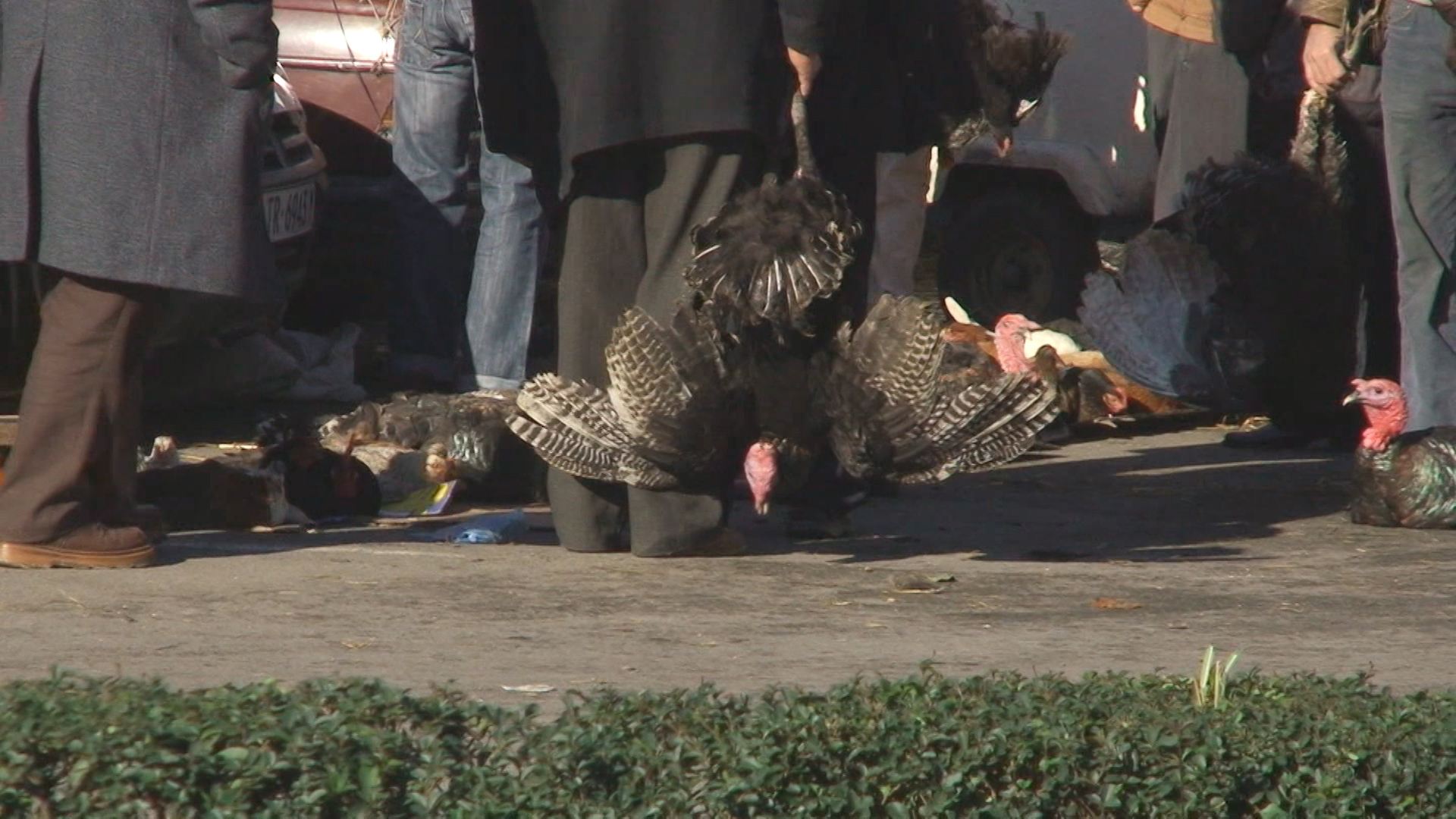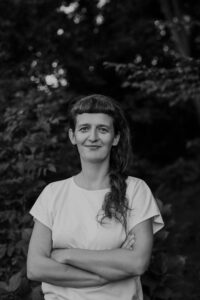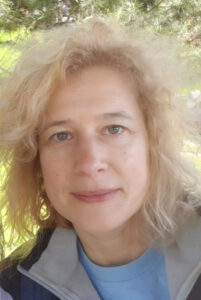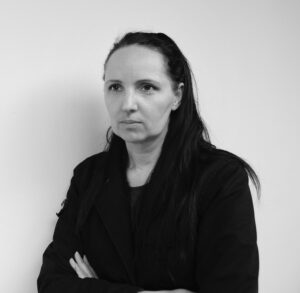Violana Murataj
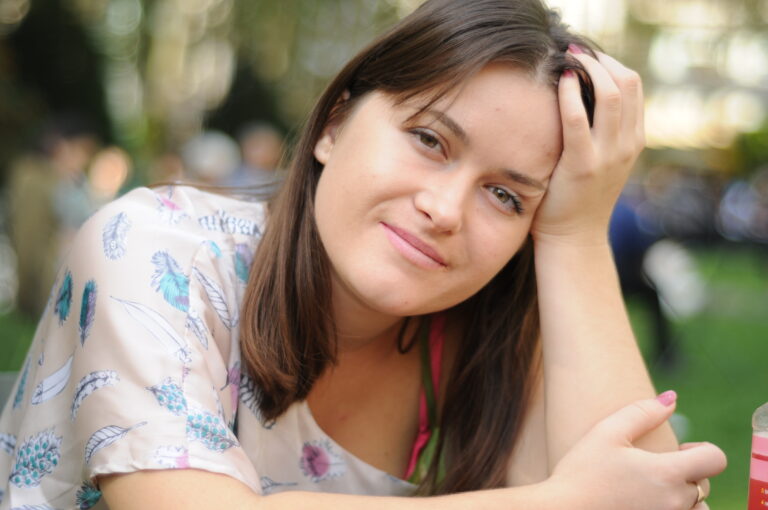
– born 1984 in Tirana – lives and works between Tirana and New York. She mainly works with the medium of Video Art. She attended the Art Academy in Tirana from 2002-2006 and afterwards the School of Visual Arts in New York, where she graduated in 2010 with a Master of Fine Arts degree at the department of MFA Photography, Video & Related Media.
I learned from my parents that I showed an interest in expressing myself through art at an early age. The Albania of my childhood was still a communist country. I did not understand well enough the meaning of some celebrations such as 1 May or 8 November, the birthdate of the Party of Labour of Albania, but I enjoyed them as celebrative rituals, thus putting them on paper in the course of my initial coloured drawings. As a teenager I recall the anarchy of 1997 and the specific roar of Kalashnikovs. In September 1998, in the main boulevard in front of the building of the Premier’s Office, very close to my house, an armed revolt took place, while I was getting ready to start my studies at the Artistic Lyceum, in the painting department. I could just open the window and see the bomb explosions and the black plume. In 2002 I was admitted to the Academy of Arts. In order to support my artistic work, I was working as a video editor in one of the main TV channels in Albania. Ironically, the company I was working for, was located inside the International Centre of Culture – otherwise referred to as the ‘Pyramid’ – which was designed to be the museum of the dictator Enver Hoxha.
I perceive art as part of my identity. The language I picked for expressing myself are the mediums I usually work with: video and photography. Art is also my profession. Thus, my practice is an individual exploration, originating from the environment and community I am living in towards the process of recognition and simultaneously metamorphosis of the self. In terms of content, my works depict the complexity and contradictions of life in Albania.
The country I have been brought up in, the history and how this reality has been transformed over the years, have had an extraordinary spiritual impact on me. I wish to know, to search and find interesting facts, in order to know and understand my identity, that of the Albanian society and of human beings overall. One of my works, My birthday (2010) 1, is a video combining documentary with performance, whereby, at the centre of the work, stands the history of Bunkers, or otherwise referred to as ‘Concrete Mushrooms’. Through this work, I discover a part of the history of Albania, disclosing at the same time a piece from my personal story and life.
Another topic that I have explored in my practice are the topics related to emigration, which has affected me directly. In the video Without Identity (2014)2, I intended to maintain an entirely demonstrative stance with regard to the emotional experience of my relocation from Albania to America. The expressiveness and the dynamics of the country where I relocated to, often brought unknown experiences, thus impacting my daily life. The intensity of life and the attempt to identify myself with another atmosphere brought about a specific emotional situation, which I tried to impart through my work.
My daily life is closely connected to my artistic practice, to research, to expand the territory of knowledge. The artistic discipline, the critical approach when reflecting reality and the current challenges, are the most direct resistance that I can have as an artist. Being a mother, woman and artist makes me often encounter silent communication, between emotion and through this, I discover unknown aspects about myself and my role in society. Art is that space of freedom wherein, beyond the ordinary and life challenges, I find tranquillity in an entirely organic way. Following a stormy day, bearing the professional load and bringing up and educating our children, late at night I find the appropriate moment when the energy of the day rejoices in a sole breathing space to create or design a new idea.
Motherhood is an internal and unique experience, a period of crisis and identity change. Encountering new interests and unknown feelings transposes into an essential motive in my creation process. I try to find a harmonic compromise between the role of the mother and the permanent transposition of my identity.
Although I do, in a number of my videos3, participate as a performer4, I did not depict topics directly connected to gender identity and motherhood. However, by featuring my representation5 in the centre of the work, I think that I have indirectly dealt with topics connected to gender identity, which can be comprehended as reinforcing and giving significance to women.
In the relationship with female artists, I find common space and interests, and I think that, if we support each-other, we are going to expand the mechanisms whereby inequality can be counteracted. A gender-related gap exists not only in the world of art, but also in the labour market overall. These elements of everyday life are certainly reflected in the creativity of every one of us.
The impact that social-political circumstances pose is unavoidable for each artist. This impacts the individual directly and, consequently, I cannot stay indifferent; it is exactly these incentives which provoke thought6; thought brings about an idea and the idea, the work of art. By way of the creative process and the concept, I try to materialise what I would refer to as ‘aesthetics of thought’: expressing in the most direct way a situation which makes me reflect.
Statement written by the artist in collaboration with Adela Demetja (2022).
1Violana Murataj, My birthday, 2010, Frame from Video, Courtesy of the artist2Violana Murataj, Without identity, 2014, Frame from video, Courtesy of the artist
3Violana Murataj, The tongue, 2012, Frame from video, Courtesy of the artist
4Violana Murataj, In front of the door, 2009, Frame from video, Courtesy of the artist
5Violana Murataj, My mother`s colors, 2011,Frame from video, Courtesy of the artist
6Violana Murataj, Roosters, 2013, Frame from video, courtesy of the artist
– lindur më 1984 në Tiranë, jeton dhe punon ndërmjet Tiranës dhe Nju Jorkut. Ajo kryesisht punon me mediumin e Video Art. Ajo ka ndjekur Akademinë e Arteve në Tiranë nga viti 2002-2006 dhe më pas Shkollën e Arteve Pamore në Nju Jork, ku u diplomua në vitin 2010 me titullin Master i Arteve të Bukura në Departamentin e Fotografisë, Videos dhe Mediave.
Nga prindërit kam mësuar se kam treguar interes për shprehjen përmes artit që në moshë të vogël. Shqipëria e fëmijërisë time ishte ende një vend komunist. Nuk i kuptoja mirë qëllimet e disa festave si 1 Maji apo 8 Nëntori, ditëlindja e Partisë së Punës së Shqipërisë, por i shijoja ato rituale festive, për ti hedhur në letër në vizatimet e mia të para me ngjyra. Si adoleshente më kujtohet anarkia e vitit 1997 dhe tingulli i veçantë i kallashnikovëve. Në Shtator të vitit 1998, në bulevardin kryesor përballë godinës së kryeministrisë, fare pranë banesës sime, u zhvillua një revoltë e armatosur ndërkohë që bëhesha gati të filloja studimet në Liceun Artistik në degën e pikturës. Po të hapja dritaren mund të shihja shpërthimet e bombave dhe tymin e zi. Në vitin 2002 u pranova në Akademinë e Arteve. Për të mbështetur punën time artistike, punoja si video editore në një nga kanalet kryesore televizive në Shqipëri. Ironikisht, kompania ku unë punoja, ndodhej në ndërtesën e Qendrës Ndërkombëtare të Kulturës – e quajtur ndryshe “Piramida” – e cila më parë ishte projektuar si muzeu i diktatorit Enver Hoxha.
Artin e ndjej si pjesë të identitetit tim. Gjuha që kam zgjedhur të shprehem janë mediumet me të cilat punoj zakonisht: video dhe fotografia. Arti është edhe profesioni im. Kështu, praktika ime është një kërkim individual, që nis nga mjedisi dhe komuniteti ku jetoj, drejt njohjes dhe njëkohësisht ndryshimit të vetvetes. Për nga përmbajtja veprat e mia trajtojnë kompleksitetin dhe kontraditat e jetës në Shqipëri.
Vendi ku jam rritur, historia dhe mënyra se si ky realitet është transformuar ndër vite, kanë pasur një impakt shpirtëror të jashtëzakonshëm tek unë. Gjithnjë e më tepër dëshiroj të di, kërkoj të gjej fakte interesante e për rrjedhojë arrij të njoh dhe kuptoj identitetin tim, të shoqërisë shqiptare dhe njeriut në përgjithësi. Një nga punët e mia Ditëlindja (2010)1, është një video që ndërthur dokumentarin me performancën, ku në qendër të veprës qëndron historia e Bunkerëve, ose të quajtur ndryshe “Kërpudhat e Betonit”. Me anë të kësaj pune unë zbuloj një pjesë të historisë së Shqipërisë, duke treguar gjithashtu dhe një copëz nga historia dhe jeta ime personale.
Një tematikë tjetër që kam eksploruar në punën time janë çështjet e lidhura me emigracionin, të cilat më përkasin në mënyrë të drejtpërdrejt. Në Videon Pa Identitet (2014)2, kam dashur të mbaj një qëndrim tejet demonstrativ lidhur me përjetimin emocional të zhvendosjes time nga Shqipëria në Amerikë. Ekspresiviteti dhe dinamikat e vendit ku u zhvendosa shpesh më sillnin të panjohura që ndikonin në përditshmërinë time. Intensiteti i jetës dhe përpjekja për tu identifikuar në një atmosferë tjetër, krijonte një gjendje specifike emocionale, të cilën jam munduar ta përçoj në vepër.
Përditshmëria ime është e lidhur ngushtë me praktikën time artistike, me hulumtimin dhe zgjerimin e territorit të njohjes. Disiplina artistike, qëndrimi kritik në pasqyrimin e realitetit dhe sfidat e aktualitetit janë rezistenca më e drejtpërdrejtë që mund të kem si artiste. Të qenurit nënë, grua, artiste më bën të gjendem shpesh përpara një komunikimi të heshtur, midis emocionit dhe mendimit, që më bën të zbuloj të panjohura rreth vetes dhe rolit tim në shoqëri. Arti është ajo hapësirë lirie ku përtej të zakonshmes dhe sfidave të jetës, gjej paqen në mënyre tejet organike. Pas një dite të vrullshme, me ngarkesën e punës dhe mbarëvajtjen në rritjen dhe edukimin e femijëve, në mbrëmjet e vona, është ai momenti, ku e gjithë energjia e ditës dëfrehet në një hapësirë të vetme frymëmarrjeje për të krijuar apo projektuar një ide të re.
Mëmësia është nje përvojë e brendshme unike, një periudhë krize dhe ndryshimi të identitetit. Përballja me interesa të reja dhe ndjesi të panjohura kthehet në një motiv thelbësor në proçesin tim krijues. Përpiqem të gjej një kompromis harmonik nëpërmjet rolit te nënës dhe transformimit të përhershëm të identitetit tim.
Edhe pse në një pjesë të videove të mia3 unë marr pjesë si performuese4, nuk kam trajtuar çështje të lidhura në mënyrë të drejtpërdrejtë me identitetin gjinor dhe mëmësinë, por duke vendosur figurën time5 në qendër të veprës së artit, mendoj se kam trajtuar në mënyrë indirekte çështje të lidhura me identitetin gjinor, që mund të kuptohen si fuqizim dhe dhënie zë gruas.
Në marrëdheniet me artistet femra gjej hapësira dhe interesa të përbashkëta dhe besoj që, nëse ne mbështesim njëra tjetrën, do të zgjerojmë mekanizmat me të cilët mund të luftojmë pabarazinë. Një hendek gjinor ekziston jo vetëm në botën e artit, por edhe në tregun e punës në përgjithësi. Këto elemente të përditshmërisë reflektohen padyshim dhe në krijimtarinë e gjithsecilës prej nesh.
Ndikimi që kanë rrethanat social-politike për cilindo artist është i pashmangshëm. Ky impakt vjen në mënyrë të drejtpërdrejtë tek individi, për rrjedhojë nuk mundem kurrsesi të jem indiferente, janë pikërisht këto ngacmime të cilat provokojnë mendimin6, mendimi sjell një ide, ideja, veprën e artit. Nëpërmjet proçesit krijues dhe konceptimit përpiqem të materializoj atë që do e quaja ”estetikë të mendimit”, shprehjen në menyrë sa më direkte kundrejt një situate që më bën të reflektoj.
Tekst i shkruar nga artistja në bashkëpunim me Adela Demetja-n (2022).
1Violana Murataj, My birthday, 2010, Imazh shkëputur nga video, Kortezi e artistes2Violana Murataj, Pa identitet, 2014, Imazh shkëputur nga video, Kortezi e artistes
3Violana Murataj, Gjuha, 2012, Imazh shkëputur nga video, Kortezi e artistes.
4Violana Murataj, Përpara një dere, 2009, Imazh shkëputur nga video, Kortezi e artistes
5Violana Murataj, Njgjyrat e mamas, 2011, Imazh shkëputur nga video, Kortezi e artistes
6Violana Murataj, Gjelat, 2013, Imazh shkëputur nga video, Kortezi e artistes
